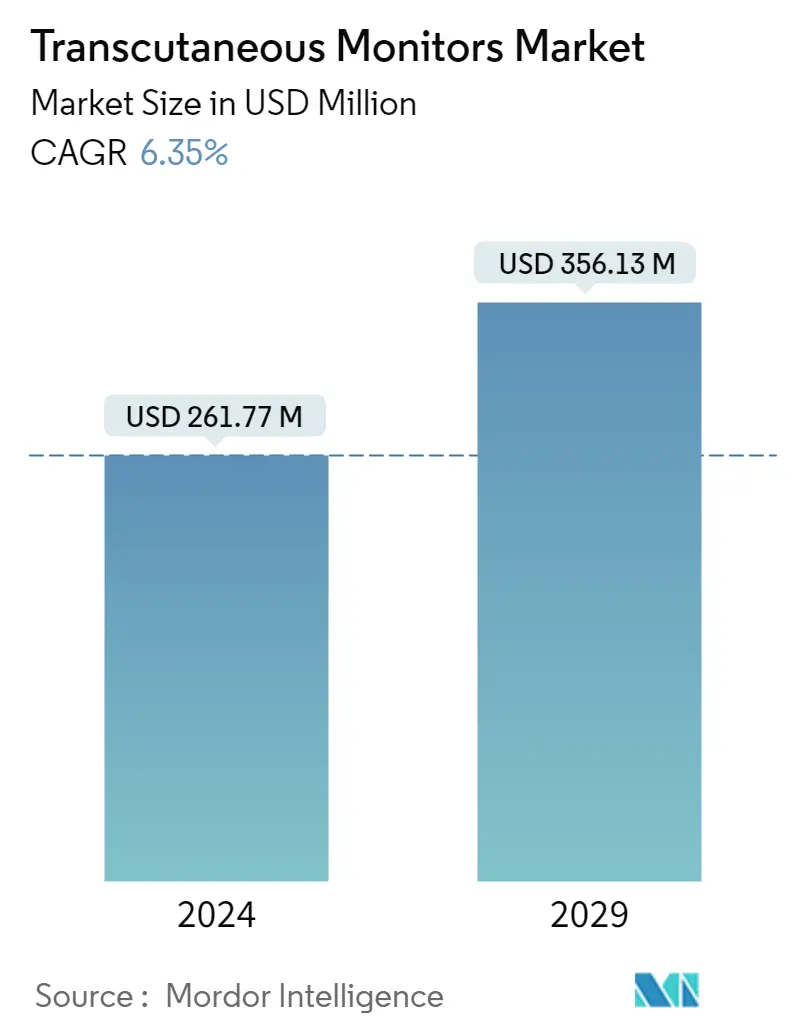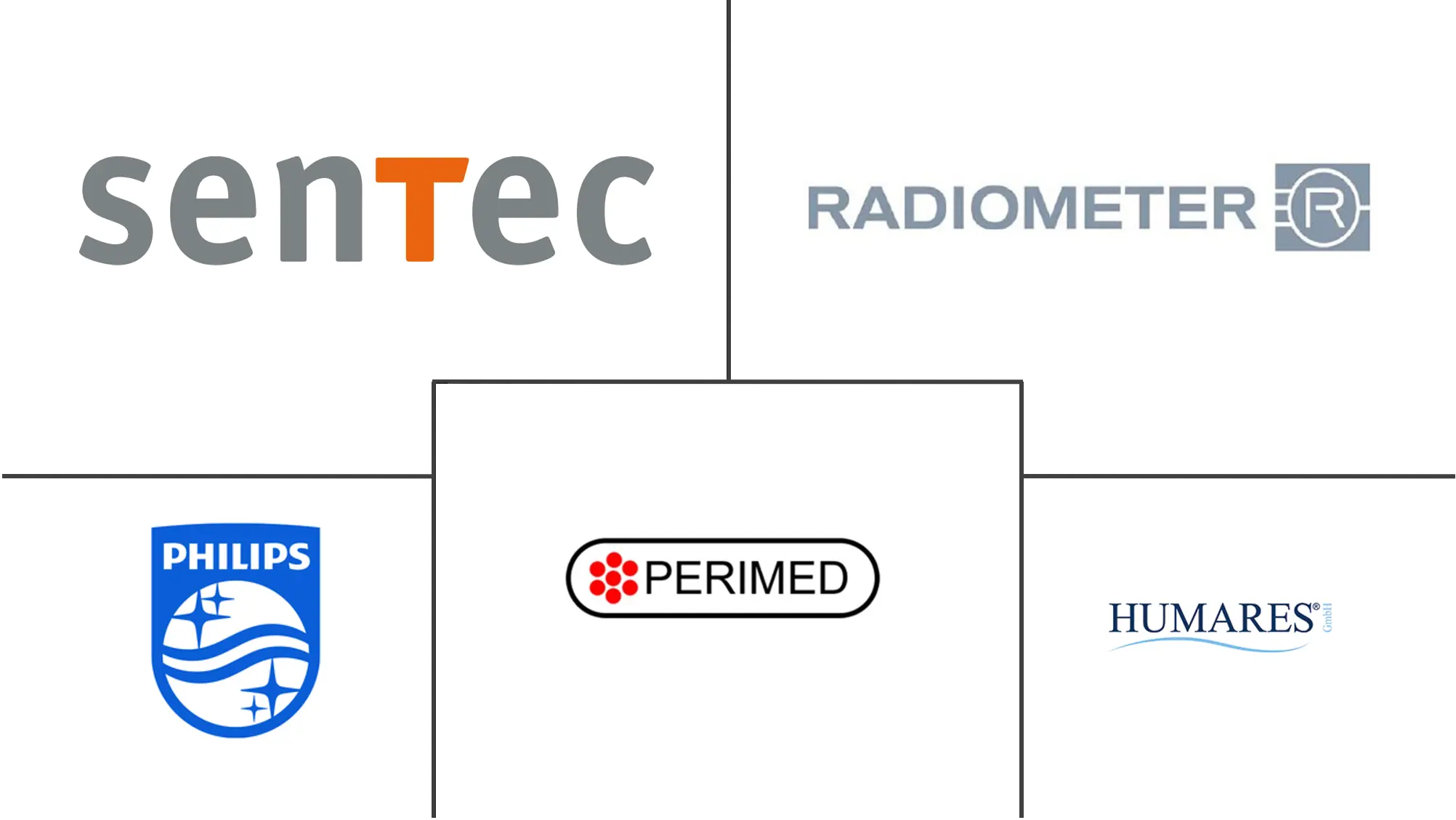Market Size of Transcutaneous Monitors Industry

| Study Period | 2021 - 2029 |
| Market Size (2024) | USD 261.77 Million |
| Market Size (2029) | USD 356.13 Million |
| CAGR (2024 - 2029) | 6.35 % |
| Fastest Growing Market | Asia Pacific |
| Largest Market | North America |
| Market Concentration | Medium |
Major Players
*Disclaimer: Major Players sorted in no particular order |
Transcutaneous Monitors Market Analysis
The Transcutaneous Monitors Market size is estimated at USD 261.77 million in 2024, and is expected to reach USD 356.13 million by 2029, growing at a CAGR of 6.35% during the forecast period (2024-2029).
The COVID-19 pandemic had a significant positive impact on the market studied. This was majorly attributed to the increasing number of patients being hospitalized for COVID-19, and the majority of them needed ventilation or continuous monitoring of oxygen levels. According to the European Respiratory Journal data published in March 2021, approximately 62.5% of the severe cases of COVID-19 in Europe had a history of COPD. Moreover, COVID-19 has also increased the burden on respiratory disease patients. This has led to the increasing demand for patient monitoring devices, such as transcutaneous monitors among critically ill patients, for better management of diseases. Hence, during the pandemic, the market studied witnessed significant growth. However, it has reached its pre-pandemic nature in terms of demand for transcutaneous monitors and is expected to witness healthy growth in the coming years.
The market studied is majorly driven by the factors such as the increasing prevalence of respiratory diseases, technological advancements in transcutaneous monitors, and the rising prevalence of chronic diseases.
Transcutaneous monitors play a crucial role in patient monitoring. The rising respiratory disease patient population often requires constant carbon dioxide and oxygen supervision with limited blood flow. Hence, transcutaneous monitors help monitor the oxygenation and ventilation in the patient's body and provide real-time information that is expected to help improve patient safety. As per the 2022 update by the Asthma and Allergy Foundation of America, approximately 25 million people in the United States have asthma. This equals about 1 in 13 people.
Additionally, as per the data from CDC published in October 2022, the percentage of adults who have ever been diagnosed with COPD, emphysema, or chronic bronchitis in the United States was 4.6% as of the year 2021. The CDC data also reported that the burden of respiratory diseases is increasing annually. Therefore, with the high prevalence of such diseases, there is a growing demand for transcutaneous monitors, which is believed to propel market growth in the coming years.
Furthermore, technological advancements in transcutaneous monitors contribute largely to market growth. For instance, as per the data from the National Institute of Health published in May 2021, wearable technology has emerged significantly and is widely practiced in transcutaneous monitors. The wearable transcutaneous CO2 monitor displays a linear response to CO2 concentration and a well-behaved response curve to humid CO2. Therefore, researchers are focusing on the development of a CO2 Monitor based on a Miniaturized Nondispersive Infrared Sensor. Hence, with such technologies, it is believed that there will be a wide range of transcutaneous monitors available in the market in the coming years, which will boost the market growth.
However, the stringent regulatory framework is expected to hinder market growth over the forecast period of study.
Transcutaneous Monitors Industry Segmentation
As per scope, transcutaneous monitors are a highly trending tool for monitoring and measuring oxygenation (tcpO2) and ventilation (tcpCO2).
The Transcutaneous Monitors Market is Segmented by Application Type (Wound Healing, Blood Gas Monitoring, Respiratory Care, Sleep Diagnostics), End User (Hospitals, Ambulatory Surgical Centers, Other End Users), and Geography (North America, Europe, Asia-Pacific, Middle East and Africa, South America). The report also covers the estimated market sizes and trends for 17 countries across major regions globally. The report offers the value in USD million for the above segments.
| By Application Type | |
| Wound Healing | |
| Blood Gas Monitoring | |
| Respiratory Care | |
| Sleep Diagnostics | |
| Others |
| By End User | |
| Hospitals | |
| Ambulatory Surgical centers | |
| Speciality Clinics |
| Geography | ||||||||
| ||||||||
| ||||||||
| ||||||||
| ||||||||
|
Transcutaneous Monitors Market Size Summary
The Transcutaneous Monitors Market is poised for significant growth, driven by the increasing prevalence of respiratory and chronic diseases, alongside technological advancements in monitoring devices. The market experienced a positive impact during the COVID-19 pandemic due to heightened demand for patient monitoring solutions, particularly for those requiring ventilation and oxygen level monitoring. This surge in demand has stabilized, returning to pre-pandemic levels, yet the market is expected to continue its upward trajectory. The role of transcutaneous monitors in providing real-time information on oxygenation and ventilation is crucial, especially for patients with respiratory conditions such as asthma and COPD. The integration of wearable technology and miniaturized sensors is further enhancing the capabilities of these monitors, promising a broader range of applications and improved patient safety.
Hospitals are anticipated to maintain a significant share of the transcutaneous monitors market, driven by their comprehensive services in blood gas monitoring, respiratory care, and neonatal monitoring. The rising incidence of preterm births and respiratory disorders, particularly in regions like North America, is fueling the demand for non-invasive monitoring systems. Strategic initiatives by key market players, including product launches and collaborations, are expected to bolster market growth. Companies such as Sentec AG, Radiometer, and Koninklijke Philips N.V. are actively engaging in these strategies to enhance their market presence. Despite the competitive landscape, the market's growth is supported by ongoing innovations and the increasing need for effective patient monitoring solutions across various healthcare settings.
Transcutaneous Monitors Market Size - Table of Contents
-
1. MARKET DYNAMICS
-
1.1 Market Overview
-
1.2 Market Drivers
-
1.2.1 Increasing Prevalence of Respiratory Diseases
-
1.2.2 Technological Advancements in Transcutaneous Monitors
-
1.2.3 Rising Prevalence of Chronic Disorders
-
-
1.3 Market Restraints
-
1.3.1 Stringent Regulatory Framework
-
-
1.4 Porter's Five Force Analysis
-
1.4.1 Threat of New Entrants
-
1.4.2 Bargaining Power of Buyers/Consumers
-
1.4.3 Bargaining Power of Suppliers
-
1.4.4 Threat of Substitute Products
-
1.4.5 Intensity of Competitive Rivalry
-
-
-
2. MARKET SEGMENTATION
-
2.1 By Application Type
-
2.1.1 Wound Healing
-
2.1.2 Blood Gas Monitoring
-
2.1.3 Respiratory Care
-
2.1.4 Sleep Diagnostics
-
2.1.5 Others
-
-
2.2 By End User
-
2.2.1 Hospitals
-
2.2.2 Ambulatory Surgical centers
-
2.2.3 Speciality Clinics
-
-
2.3 Geography
-
2.3.1 North America
-
2.3.1.1 United States
-
2.3.1.2 Canada
-
2.3.1.3 Mexico
-
-
2.3.2 Europe
-
2.3.2.1 Germany
-
2.3.2.2 United Kingdom
-
2.3.2.3 France
-
2.3.2.4 Italy
-
2.3.2.5 Spain
-
2.3.2.6 Rest of Europe
-
-
2.3.3 Asia-Pacific
-
2.3.3.1 China
-
2.3.3.2 Japan
-
2.3.3.3 India
-
2.3.3.4 Australia
-
2.3.3.5 South Korea
-
2.3.3.6 Rest of Asia-Pacific
-
-
2.3.4 Middle-East and Africa
-
2.3.4.1 GCC
-
2.3.4.2 South Africa
-
2.3.4.3 Rest of Middle-East and Africa
-
-
2.3.5 South America
-
2.3.5.1 Brazil
-
2.3.5.2 Argentina
-
2.3.5.3 Rest of South America
-
-
-
Transcutaneous Monitors Market Size FAQs
How big is the Transcutaneous Monitors Market?
The Transcutaneous Monitors Market size is expected to reach USD 261.77 million in 2024 and grow at a CAGR of 6.35% to reach USD 356.13 million by 2029.
What is the current Transcutaneous Monitors Market size?
In 2024, the Transcutaneous Monitors Market size is expected to reach USD 261.77 million.

